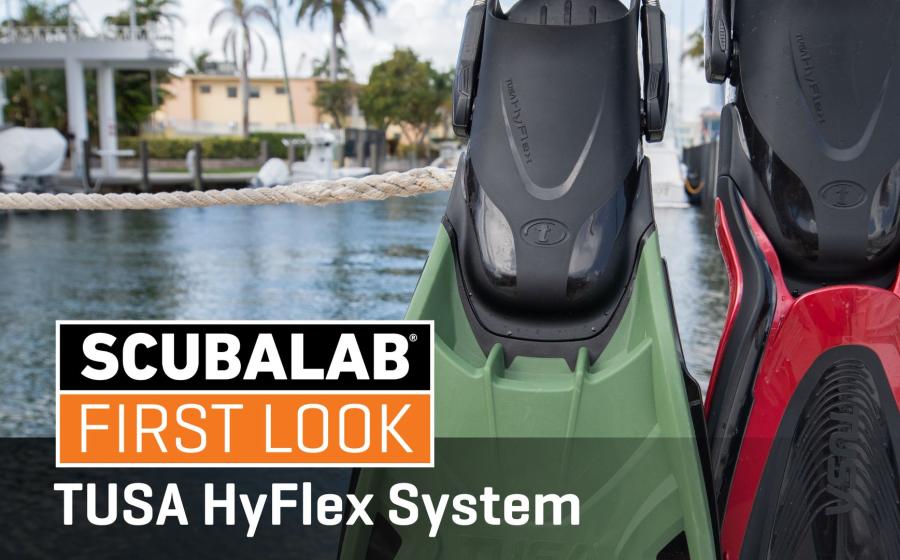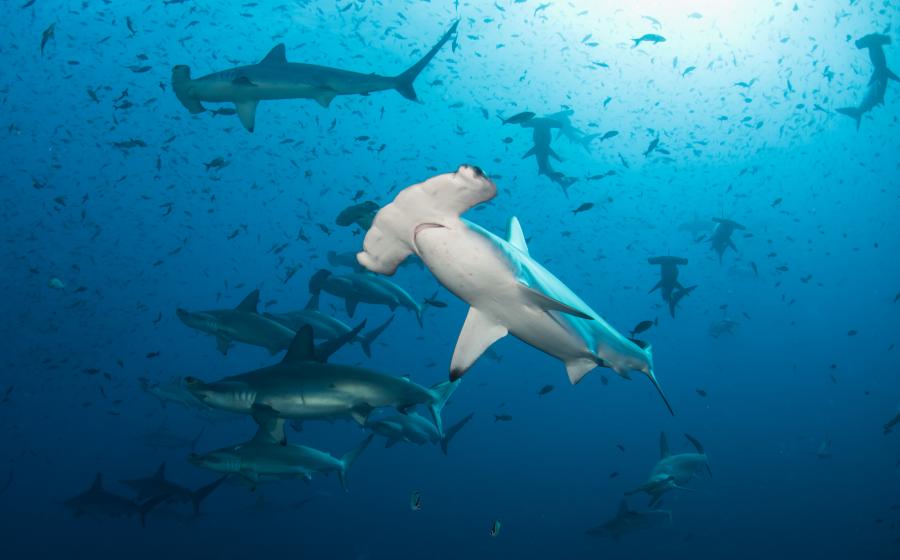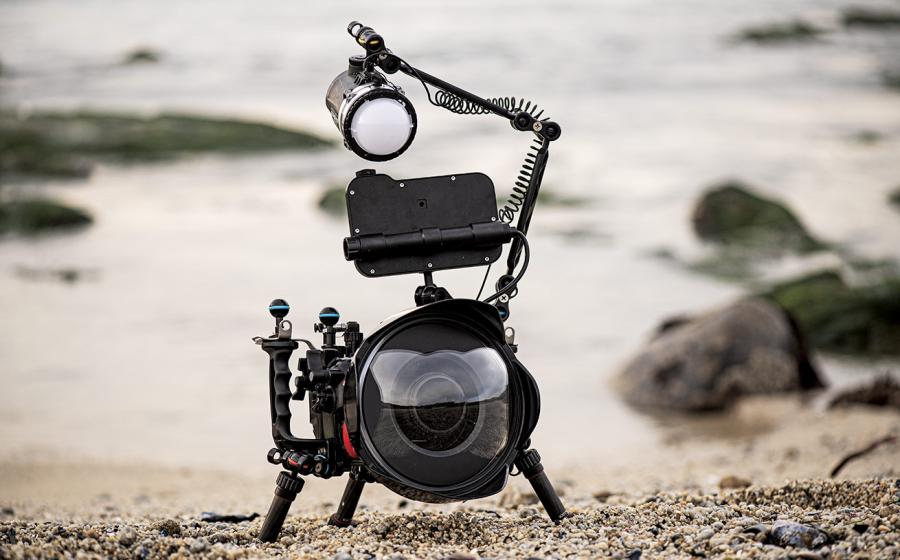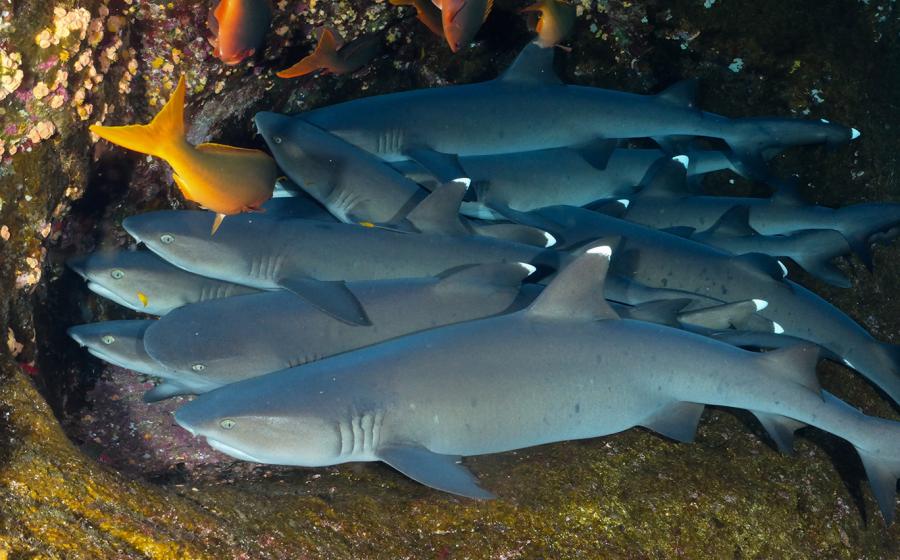A Submerged Town at Round Valley, Lebanon, New Jersey?
August 8, 2002
Round Valley reservoir is part of the NJ park system and is most often used for recreational fishing, swimming and camping. The park is less often used for scuba diving. To our knowledge, most of the lake's terrain is undocumented, nothing can be had on the Internet, or usenet.
History:
Over 50 years ago, it was once a town in a valley that was purchased by the government, then dammed at its exits, allowed to slowly flooded from ground water, later actively pumped up to flood the area to its current level. Its used as a reserve water supply to the NJ water system, should the principle reservoir run low. Direction to Round Valley are available from any website on the NJ park system.
http://www.state.nj.us/dep/forestry/parks/round.htm
Almost no reports exist on diving the open lake at Round Valley. So, I thought this would help those with adventure fever start where we left off.
$7 is charged for an entrance fee, and divers must report their plans to the ranger station, and report back to the station exactly at 4pm, or be banned from the lake. Maps of the reservoir are available through its website, and free on site, but detailed maps of the former town are taken from fishing maps [ Walmart map for about $8.] We saw mostly sunfish in the lake. We were told by park rangers that there is NO SWIMMING OR DIVING at the reservoir, except where designated, yet earlier calls to the station mentioned that the lake was available so long as we took a dive flag and logged our dive plan with the station. I STRONGLY suggest you inquire at the station and log your dive plan, should you choose to dive the lake. Any artifacts found should be turned in to the rangers, per lengthy rules :)
Dive Planning:
The Valley is about 400 feet above sea level, but this factors little into the dive plan.
My buddy located clusters of houses around the remnants of the road system, found old aerial photos and maps of the town. If you match the terrain of the images to the photos, you'll find the best collection of houses to dive. He wanted to see what the lake would yield, so invited me to dive Round Valley.
Maps directly available from the ranger station include distance, terrain and estimated depths, and houses are located far from shore, and in water at least from 40-60' deep. However, the road system used by the town is at the 90' mark, and just immediately EAST of the submerged road, it plunges to areas as deep as 160'. Note, depths assume the lake's water level is at maximum. When we were there, the shoreline was at least 10' lower than normal.
The cluster of houses marked on the map is over a 1000 feet from entrance point, marked E on the map. The northernmost houses are another 1000' North from houses we planned for.
The size, terrain, and depth of the lake are not for inexperienced divers. You must have excellent navigation skills, doubles, a dry suit, a bright or HID light, comfortable in cold water, bad vis and preferably technically trained for decompression. There are no park benches in the dive area, so bring your own table to help gear up.
The cluster of houses we planned for, and found, are marked X in the map. The northern cluster was preferred, but getting there was not easy. My Buddy suggested we drive on the 'do not drive' zones, and swim in the 'do not swim' zones in order to reach the bigger cluster of houses, but I chose not too, assuming we are caught, and then banned from the park to make future attempts impossible.
We dove this lake once before. To reach deep water required a 20 min long swim in shallow water on flat terrain, not more that 30'. However, we did reach 85' before turning back, as one buddy was low on gas. Today's dive we planned with divers only on doubles. We would use the flat terrain of the inbound swim as our depth reference for decompression, if necessary. As the potential for depth and exertion was there and Buddy was not trimix certified, we planned on air to a max depth of 130', with 02 deco, for a total decompression obligation of 5 min time, not bottom time. Planned as a multilevel dive on Decoplanner to consume 2/3rd of gases in the out and inbound dive phases, I estimated only 1 minute at 130' by the time we reached the site, and over 1 hour of dive time.
The Dive, the underwater terrain and houses:
We geared up and entered the water with crystal clear visibility to 20', pulling a dive flag behind us, and just before plunging in, are interrupted by a park ranger who states we cannot dive the lake! This is cleared up and we proceed.
The 20' vis soon degenerated to 10 mucky feet about 10 minutes off shore. The bottom of the lake is a very fine silt, frog kicking the distance is recommended as its easy enough to stir, and did. The 70F water temp dropped quickly to 50F past the thermocline at 30', and the vis deteriorated to 10' or less. The bottom of the lake is festooned with lost fishing lures with hooks, rare beer cans, rarer bottles, and one paddle. Otherwise flat and featureless, one can easily loose direction and need to strictly maintain the planned compass heading. Not knowing how the boaters respected the dive flag, I kept notice of boats, fishing line, and sounds of engines as the "grrrrrr" crossed atop us.
We continued this featureless and lifeless terrain for over 20 minutes at 30', until Buddy decides to abort the dive. We surface after a mid-water safety stop, and note we are on the right heading what appears like 1500' from shore. I suggest we push on our heading for 10 minutes then turn if we find nothing, as we both have plenty of gas. We submerge and press on. At the 5 minute mark, the terrain abruptly drops deeper, becomes colder and vis increases to 20', and depth leveled off at 50', with a visible drop ahead to a deeper depth. At this point I note Buddy is missing. I do a 360 and wave my HID light, and begin to head back on a reverse heading should Buddy be immediately behind me.
The Houses:
I immediately notice a grey stone wall at the base of the 50' mark. This wall is at least 5' tall, and constructed like many old homes in Pennsylvania. There is no life at this depth, no fish, weeds, just silt and water. The area had little in terms of recent debris, and there were traces of wood submerged within the silt. This wall had a small series of steps leading into a flat area, and as I followed it on a Westward heading, noted its rectangular shape, and the base was nearly covered in silt. The 'deeper drop off' that was immediately East of it could be the road, or its driveway. This structure appeared like the foundations of a house. There were some items sticking out of the silt within the base of this structure, and I noted another wall more South of this wall ... all at about 40'. Resisting the urge to explore further, I marked the area with a reel, and ascended from the spot to find Buddy.
A Problem:
I surface to find my buddy headed to shore and I note the surface location for a potential future boat attempt. It takes me 45 minutes to swim back to shore on the surface. We discuss diving practices thereafter. Buddy chose to surface swim back to shore without me, exposing himself to boat traffic without the dive flag as marker. He chose not to drop down the flag as I dove once he surfaced. He looses me in 40' of water, and also sites buoyancy issues with gear. He claims to have cave training. Hmmm ?
Conclusion:
The foundation are all that remain of a pair of houses submerged in Round Valley Reservior. They are located about 1500-1800' feet off shore, at a general NE heading from an area specified on the map. Expect to swim 3600' feet round trip to make these houses. I regret not having the time to explore and hunt for artifacts, but it seems unique underwater archeology can be had here. You may be the lucky one. An easier approach would be to take this dive on a boat to minimize the swimming, but as its poorly documented, the exact GPS coordinates or traingulation headings remain to be done. While the water is generally shallow at first, the potential for deep water excursions as suggested by the map suggest you plan these dives as deep dives.
GOOD LUCK AND HAPPY HUNTING.
August 8, 2002
Round Valley reservoir is part of the NJ park system and is most often used for recreational fishing, swimming and camping. The park is less often used for scuba diving. To our knowledge, most of the lake's terrain is undocumented, nothing can be had on the Internet, or usenet.
History:
Over 50 years ago, it was once a town in a valley that was purchased by the government, then dammed at its exits, allowed to slowly flooded from ground water, later actively pumped up to flood the area to its current level. Its used as a reserve water supply to the NJ water system, should the principle reservoir run low. Direction to Round Valley are available from any website on the NJ park system.
http://www.state.nj.us/dep/forestry/parks/round.htm
Almost no reports exist on diving the open lake at Round Valley. So, I thought this would help those with adventure fever start where we left off.
$7 is charged for an entrance fee, and divers must report their plans to the ranger station, and report back to the station exactly at 4pm, or be banned from the lake. Maps of the reservoir are available through its website, and free on site, but detailed maps of the former town are taken from fishing maps [ Walmart map for about $8.] We saw mostly sunfish in the lake. We were told by park rangers that there is NO SWIMMING OR DIVING at the reservoir, except where designated, yet earlier calls to the station mentioned that the lake was available so long as we took a dive flag and logged our dive plan with the station. I STRONGLY suggest you inquire at the station and log your dive plan, should you choose to dive the lake. Any artifacts found should be turned in to the rangers, per lengthy rules :)
Dive Planning:
The Valley is about 400 feet above sea level, but this factors little into the dive plan.
My buddy located clusters of houses around the remnants of the road system, found old aerial photos and maps of the town. If you match the terrain of the images to the photos, you'll find the best collection of houses to dive. He wanted to see what the lake would yield, so invited me to dive Round Valley.
Maps directly available from the ranger station include distance, terrain and estimated depths, and houses are located far from shore, and in water at least from 40-60' deep. However, the road system used by the town is at the 90' mark, and just immediately EAST of the submerged road, it plunges to areas as deep as 160'. Note, depths assume the lake's water level is at maximum. When we were there, the shoreline was at least 10' lower than normal.
The cluster of houses marked on the map is over a 1000 feet from entrance point, marked E on the map. The northernmost houses are another 1000' North from houses we planned for.
The size, terrain, and depth of the lake are not for inexperienced divers. You must have excellent navigation skills, doubles, a dry suit, a bright or HID light, comfortable in cold water, bad vis and preferably technically trained for decompression. There are no park benches in the dive area, so bring your own table to help gear up.
The cluster of houses we planned for, and found, are marked X in the map. The northern cluster was preferred, but getting there was not easy. My Buddy suggested we drive on the 'do not drive' zones, and swim in the 'do not swim' zones in order to reach the bigger cluster of houses, but I chose not too, assuming we are caught, and then banned from the park to make future attempts impossible.
We dove this lake once before. To reach deep water required a 20 min long swim in shallow water on flat terrain, not more that 30'. However, we did reach 85' before turning back, as one buddy was low on gas. Today's dive we planned with divers only on doubles. We would use the flat terrain of the inbound swim as our depth reference for decompression, if necessary. As the potential for depth and exertion was there and Buddy was not trimix certified, we planned on air to a max depth of 130', with 02 deco, for a total decompression obligation of 5 min time, not bottom time. Planned as a multilevel dive on Decoplanner to consume 2/3rd of gases in the out and inbound dive phases, I estimated only 1 minute at 130' by the time we reached the site, and over 1 hour of dive time.
The Dive, the underwater terrain and houses:
We geared up and entered the water with crystal clear visibility to 20', pulling a dive flag behind us, and just before plunging in, are interrupted by a park ranger who states we cannot dive the lake! This is cleared up and we proceed.
The 20' vis soon degenerated to 10 mucky feet about 10 minutes off shore. The bottom of the lake is a very fine silt, frog kicking the distance is recommended as its easy enough to stir, and did. The 70F water temp dropped quickly to 50F past the thermocline at 30', and the vis deteriorated to 10' or less. The bottom of the lake is festooned with lost fishing lures with hooks, rare beer cans, rarer bottles, and one paddle. Otherwise flat and featureless, one can easily loose direction and need to strictly maintain the planned compass heading. Not knowing how the boaters respected the dive flag, I kept notice of boats, fishing line, and sounds of engines as the "grrrrrr" crossed atop us.
We continued this featureless and lifeless terrain for over 20 minutes at 30', until Buddy decides to abort the dive. We surface after a mid-water safety stop, and note we are on the right heading what appears like 1500' from shore. I suggest we push on our heading for 10 minutes then turn if we find nothing, as we both have plenty of gas. We submerge and press on. At the 5 minute mark, the terrain abruptly drops deeper, becomes colder and vis increases to 20', and depth leveled off at 50', with a visible drop ahead to a deeper depth. At this point I note Buddy is missing. I do a 360 and wave my HID light, and begin to head back on a reverse heading should Buddy be immediately behind me.
The Houses:
I immediately notice a grey stone wall at the base of the 50' mark. This wall is at least 5' tall, and constructed like many old homes in Pennsylvania. There is no life at this depth, no fish, weeds, just silt and water. The area had little in terms of recent debris, and there were traces of wood submerged within the silt. This wall had a small series of steps leading into a flat area, and as I followed it on a Westward heading, noted its rectangular shape, and the base was nearly covered in silt. The 'deeper drop off' that was immediately East of it could be the road, or its driveway. This structure appeared like the foundations of a house. There were some items sticking out of the silt within the base of this structure, and I noted another wall more South of this wall ... all at about 40'. Resisting the urge to explore further, I marked the area with a reel, and ascended from the spot to find Buddy.
A Problem:
I surface to find my buddy headed to shore and I note the surface location for a potential future boat attempt. It takes me 45 minutes to swim back to shore on the surface. We discuss diving practices thereafter. Buddy chose to surface swim back to shore without me, exposing himself to boat traffic without the dive flag as marker. He chose not to drop down the flag as I dove once he surfaced. He looses me in 40' of water, and also sites buoyancy issues with gear. He claims to have cave training. Hmmm ?
Conclusion:
The foundation are all that remain of a pair of houses submerged in Round Valley Reservior. They are located about 1500-1800' feet off shore, at a general NE heading from an area specified on the map. Expect to swim 3600' feet round trip to make these houses. I regret not having the time to explore and hunt for artifacts, but it seems unique underwater archeology can be had here. You may be the lucky one. An easier approach would be to take this dive on a boat to minimize the swimming, but as its poorly documented, the exact GPS coordinates or traingulation headings remain to be done. While the water is generally shallow at first, the potential for deep water excursions as suggested by the map suggest you plan these dives as deep dives.
GOOD LUCK AND HAPPY HUNTING.






